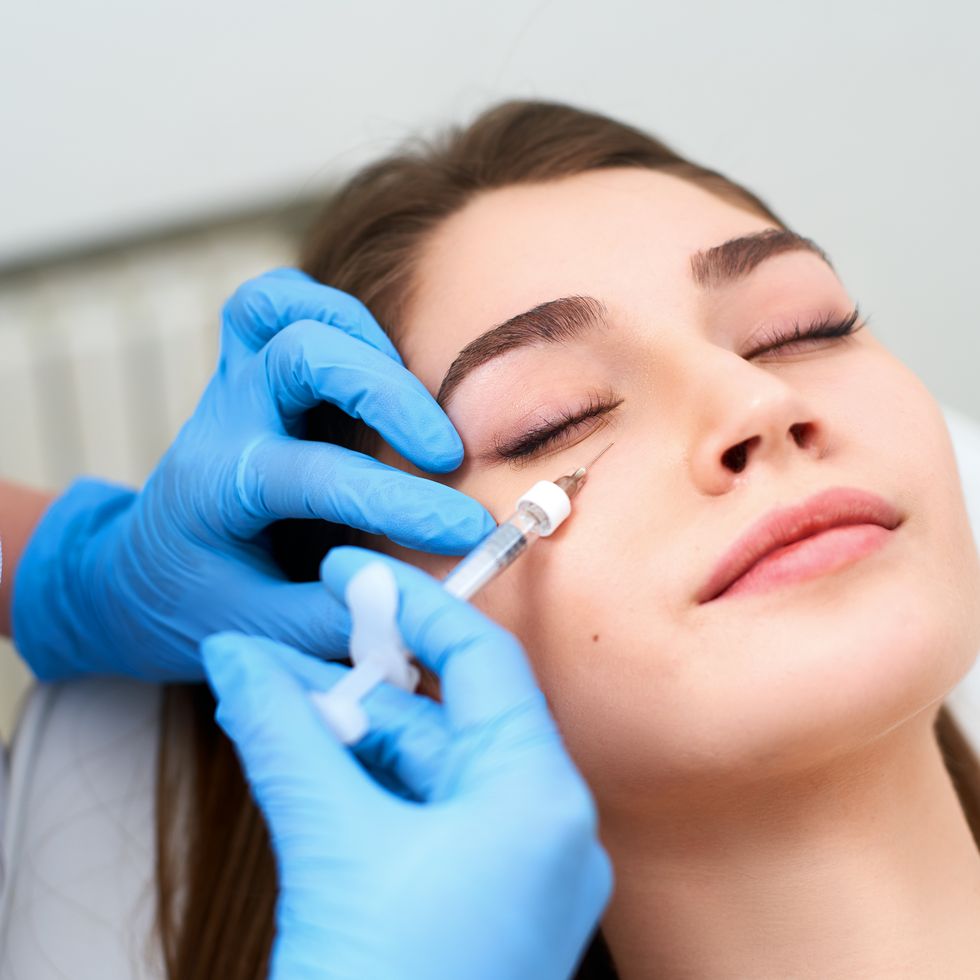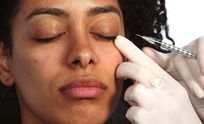If your eyes appear tired all the time — with dark circles or a sunken and hollow look — you might be one of the many people who don’t get enough sleep. But if you feel rested, and you know you’re getting the requisite quality and quantity of good ZZZs, Not you may be intrigued about a cosmetic procedure that could make you look better rested: an injection of dermal fillers in the under-eye area. Could you be a good candidate? Here’s the science about this procedure, as well as information from a top dermatologist about what problems it can — and can’t— improve.
First, what are dermal fillers?
Under-eye fillers are one type of cosmetic dermal filler. On the whole, dermal fillers are very popular: According to the American Society of Plastic Surgeons, 3.4 million procedures using “soft-tissue” cosmetic fillers were performed in 2020 (this includes all fillers, not just those involving the under-eye area).
Dermal fillers are regulated by the Food and Drug Administration (FDA) as medical devices, and the FDA states that studies of dermal fillers (ones that have been FDA-approved) indicate that people are generally satisfied with the results.
What is under-eye filler?
In this type of dermal filler procedure, hyaluronic acid filler is injected in the under-eye area, and because it fills in the space, fans say it improves the look of dark circles and/or sunken eyes. According to the FDA, hyaluronic acid is a polysaccharide (a type of sugar) that’s naturally found in our body tissues. In gel form, it combines with water and swells, which gives a smoothing or filling effect. The American Academy of Facial Plastic and Reconstructive Surgery (AAFPRS) says that because hyaluronic acid is a soft, gel-like substance, it’s used in areas where this softness is important, like the eye and lip area. It’s absorbed by the body over time, which is why the dermal filler has a temporary effect.
“Hyaluronic acid is in our bodies naturally, around our bones and in our skin, from birth,” says dermatologist Mona Gohara, M.D., associate clinical professor of dermatology at Yale School of Medicine. “It’s like a microsponge when it absorbs water in our bodies — it puffs out! As you age, you gradually lose hyaluronic acid, and your skin begins to lose its buoyancy and begins to dry out, sag, and wrinkle. Because hyaluronic acid has this water absorption, when it’s used as filler it expands the skin and also smoothes out fine lines and wrinkles.”
What are the benefits of under-eye fillers?
“The biggest thing this procedure fixes is a sunken hollow under the eye, which casts a shadow under the eyes, causing dark circles,” says Dr. Gohara. “The hollow is brought on by a lack of collagen and hyaluronic acid, and you’re effectively replacing it with the filler.” The filler can help add volume to the area, which can de-emphasize the circles.
As reported in the Annals of Dermatology, dark circles aren’t a medical issue; they’re a cosmetic concern. Hyaluronic acid, given via microneedle, can be used for improving dark circles caused by thin skin or tear troughs (a fancy name for the natural depression under the eye, nearest to the nose), as well as nearby wrinkles or lax skin. These tear troughs can cause the appearance of dark circles by “casting a dark shadow over the lower eyelid,” according to 2012 research published in the Journal of Cutaneous and Aesthetic Surgery.
When is under-eye filler not the best option?
“Hyperpigmentation under the eyes can also be from either melanin [naturally darker skin under the eyes] or blood vessels right under the skin,” says Dr. Gohara. “In that case, you may not get the results that you would when the under-eye circles are due to the shadow from the hollow. The treatment is much more effective when there’s the shadow from the hollow.” But, she continues, “If the doctor is able to separate the skin from the underlying vessels and create a little bit of a distance between them with the filler, then it can work a bit. But the best result will be when there’s darkness from a sunken or hollow area under the eyes.”
What are the side effects of under-eye fillers?
According to the American Society of Plastic Surgeons, you can expect some bruising, since the under-eye area has thinner skin with lots of blood vessels. Swelling is common as well. There are other possible side effects: If the fillers aren’t injected correctly, the area can end up looking more swollen and discolored. This can be treated via injection with an enzyme that breaks down the filler. Infections or the development of nodules are also possible (and treatable) side effects. Then there are far more serious — but rare — complications, including blindness. And that underscores the fact that you really, really need to seek out a doctor who is well-trained in the procedure — meaning a board-certified dermatologist who’s been trained in cosmetic treatments or a board-certified plastic surgeon. It’s better not to risk going to a “med-spa”— stick to a board-certified physician. Says Dr. Gohara, “This is a tricky situation, working in the eye area, where things can go wrong. This is not a moment when you should be using that Groupon! There’s a reason why people went to med school for this.”
How does under-eye filler compare with Botox?
They’re very different. A neurotoxin, Botox (and other similar neurotoxin products) is injected in small amounts into your facial muscles, according to the AAFPRS; this keeps your muscles from contracting, leading to the relaxation of the skin, which gives it a smoother look. “Botox relaxes those muscles,” says Dr. Gohara. “Under-eye filler is totally different — you’re adding volume.” These fillers don’t affect the muscles.
How to prep for the procedure if you’re getting under-eye filler:
“It’s important to consult with the doctor in advance, so they can assess your specific anatomy,” says Dr. Gohara. And according to the Journal of Cutaneous and Aesthetic Surgery, certain things should be avoided for at least five days before the procedure to reduce the chance of bruising: aspirin and NSAIDs, vitamin E, and gingko biloba. Dr. Gohara suggests stopping fish oil supplements as well. “In the days leading up to the procedure, you want to lay off anything that could thin the blood, which would lead to more bruising. You don’t want to look like you got in a fight in a bar,” she says. “Some dermatologists suggest taking arnica supplements — and one thing I suggest to patients is to eat some pineapple the week before, because it has a group of enzymes called bromelain that can help with bruising. It’s anecdotal, but it’s not bad for you and may even help!”
What happens during the procedure:
“Some dermatologists apply a topical numbing agent; there’s no needle numbing involved,” says Dr. Gohara. Other times the numbing agent is mixed in with the product, so there’s no advance numbing. Then any numbing cream is wiped off, and the area is cleaned. I have the patient semi-laying down — I want them to be comfortable, but I also want to see how they look with normal gravity when I do the procedure.”
Then it’s time for the injection. “The doctor grabs a preloaded syringe, sometimes with lidocaine mixed in it, which constricts vessels as well as numbs. The doctor injects it into the skin, under the epidermal/dermal area [the top layers], to add volume. The whole thing takes 15-30 minutes, soup to nuts. The doctor might apply a tiny bit of pressure to set it, but not a heavy or firm massage.”
An advantage with hyaluronic acid, adds Dr. Gohara, is that it can be dissolved if there’s a problem. “If someone doesn’t like the results, you want the option to dissolve it.”
What’s involved with after care?
“Right afterward, sometimes the doctor will apply ice, to bring down inflammation,” says Dr. Gohara. “I tell my patients to avoid vigorous exercise that evening, and they can return to normal activity the next day. This is meant to be easy and low maintenance for the patient, with a good outcome.”
How long do under-eye fillers last?
Hyaluronic acid filler is gradually absorbed by the body. Says Dr. Gohara, “People metabolize things differently — generally, under-eye fillers last for 6 months to a year.”
Who should avoid dermal fillers?
According to the FDA, dermal fillers might not be right for those with bleeding conditions, some allergies and certain other medical conditions; the FDA suggests having a conversation with your personal doctor to make sure the procedure is right for you, and that you ask the medical professional who will be doing the procedure to clearly explain the benefits and potential risks.
How much does it cost to get under-eye fillers?
The American Society of Plastic Surgeons says that the average cost of hyaluronic acid filler is $684 per syringe, according to their 2020 statistics — but they make the point that there’s a variety in what a patient might actually pay, depending on geographic location, the experience and expertise of the physician, and how complicated the procedure is on the specific patient.

Executive Director
Lisa (she/her) is the executive director of the Hearst Health Newsroom, a team that produces health and wellness content for Good Housekeeping, Prevention and Woman’s Day. Formerly the executive editor of Women’s Health, The Good Life and Parenting magazines and a senior editor at Esquire and Glamour, she specializes in producing investigative health reports and other stories that help people live their healthiest possible lives. She has won many editing awards, including the National Magazine Award.
Denial of responsibility! My Droll is an automatic aggregator of Global media. In each content, the hyperlink to the primary source is specified. All trademarks belong to their rightful owners, and all materials to their authors. For any complaint, please reach us at – [email protected]. We will take necessary action within 24 hours.



